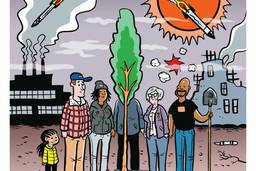Defending the Commons: 40 Years of In These Times
As the corporate assault on the environment grow, so does the movement against it.
Dayton Martindale

The human species’ impact on this planet has been the ecological equivalent of an asteroid hitting the Yucatán. Extinction rates are higher now than they’ve been since that event wiped out the dinosaurs, and soaring carbon dioxide levels suggest the worst is yet to come.
While Homo sapiens are broadly responsible, much of the blame lies less with ordinary individuals than with the corporate handmaidens of a rapacious, extraction-based economic system.
In the words of Utah Phillips — an anarchist labor organizer and folk singer who In These Times’ Jay Walljasper once said has “enough stage presence to make Clint Eastwood seem like a nervous understudy” — “The earth is not dying, it is being killed, and those who are killing it have names and addresses.”
In These Times has spent 40 years taking down those names, chronicling both the corporate assault on the environment and the movement to halt it. At a time when much environmental coverage was limited to the occasional tree-planting ceremony or Earth Day celebration, ITT put substantial resources into investigating emerging threats to human health and the biosphere.
“Real environmental stories are inherently critical of corporate priorities and governmental subservience to those priorities,” said founding editor James Weinstein in a 1988 interview with Fairness and Accuracy in Media Reporting.
Likewise, as any longtime reader will know, real environmental solutions will not come from everyday consumers buying fluorescent light bulbs or “eco-friendly” laundry detergent. Instead, they’ll require taking on the corporations that have blithely devastated the water, soil and air in search of profit.
Doing so has often proved a challenge for the mainstream environmental movement, frequently criticized in this newspaper-turned-magazine as too white and too business-friendly. Recent years have seen the growth of a more militant and inclusive climate justice movement — take, for example, the September 2014 People’s Climate March, when over 400,000 indigenous, labor, youth and other activists marched through the streets of New York City. It’s a moment full of promise, but also potential pitfalls. Climate change and other ecological perils loom larger than ever, and we must learn all we can from the struggles of the past if we intend to have a future.
WORSE THAN WE THOUGHT
In the early 1970s, a robust environmental movement helped usher in the creation of the Environmental Protection Agency (EPA) and legislation like the Endangered Species Act and the Clean Water Act—all under Richard Nixon, no less.
In These Times was founded in the wake of those heady days, but the early victories didn’t last. Progress made by the movement was quickly diminished, or erased entirely, amidst a broader neoliberal push against regulation. In a January 1988 cover story, Dick Russell showed how the Reagan EPA had systematically weakened regulations on toxic chemicals from pesticides, herbicides, incinerators and mining operations. The environmentalists interviewed, including Ralph Nader, speculated that these regulators were angling for well-paid industry jobs. (This is a theme that repeats itself across ITT’s coverage: Just last year, a 4,600-word investigation by Valerie Brown and Elizabeth Grossman revealed how the revolving door between government and industry prevents adequate regulation of hazardous compounds.)
In the absence of strong regulations, industry ran amok. Early on, In These Times sounded the alarm about the growth of industrialized food production. In a 1979 article, Jim Mason described the torturous conditions for animals, dangerous overuse of antibiotics and health hazards created by modern factory farms.
Capitalism’s multi-pronged war on the commons, of course, didn’t end there. The paper also covered such threats as contamination from copper mines on Native American land in the ‘70s, and, in the late ‘80s and ‘90s, the lumber industry’s designs on old-growth forests in the Pacific Northwest — spotted owl populations be damned.
In January 1989, In These Times began a three-part series by Dick Russell on the causes of the greenhouse effect and the political impediments to action. Much of it could have been written today.
Russell recounts how as early as 1983, the EPA had recommended taking “immediate steps to deal with expected changes in world temperature.” Reagan’s science adviser called this “alarmist” (though outright denialism had not yet captured the Republican Party), instead embracing a National Academy of Sciences report that allowed a two-decade window before “drastic plans” would become necessary. Of course, 2003 came and went.
In the final installment, Russell outlines two visions of 2010: In the first, solar-powered electric cars rule the streets and “a network of small but productive farms operating without petro-chemical pesticides” provides food. In the second, carbon dioxide emissions have risen by 38 percent since 1989 and “millions of lush acres of tropical rainforest … stand barren.”
The reality has been even worse than Russell’s worst-case scenario. By 2010, emissions had risen by more than 50 percent; they have risen more than 60 percent today. And — largely driven by food corporations — 30 million acres of rainforest are destroyed each year, releasing carbon into the air, threatening indigenous cultures and extinguishing species.
Yet, few mainstream politicians give the issue sufficient priority. Climate went unmentioned in 2012’s Obama-Romney debates, and Hillary Clinton largely stopped mentioning it in her speeches after Bernie Sanders dropped out of the race — although she did bring it up in her first debate with Trump.
GREEN PEOPLE POWER
The lesson is clear: Absent pressure from the Left and from grassroots movements, politicians will fail to act on even the most existential of threats.
We have proof that protest and direct action works — look no further than Obama’s long-overdue rejection of the Keystone XL pipeline last year, which came after years of marches and blockades, as well as a pledge to commit civil disobedience if the pipeline was approved, signed by nearly 100,000 people.
This is a welcome change from years of an insular, often short-sighted movement. Throughout the ‘90s, In These Times senior editor Salim Muwakkil wrote about the failure of predominantly white environmental groups to effectively connect with communities of color on issues affecting their daily lives. Muwakkil looked favorably on the growth of “environmental justice,” centering the marginalized in environmental advocacy — an emphasis that is much more prominent in today’s movement.
Indeed, in a November 2014 cover story (excerpted from her book, This Changes Everything: Capitalism vs. the Climate), former In These Times contributor Naomi Klein argued that climate change is an opportunity to unite the Left, as it reveals shared interests in a livable planet, and common enemies in the form of corporate power.
Not everyone has gotten the memo. In September, the AFL-CIO released a statement in support of the Dakota Access Pipeline, an oil pipeline facing fierce resistance from indigenous activists and environmentalists.
The tension between greens and blue-collar workers is nothing new, but it’s also not inevitable. In These Times has written about efforts such as Environmentalists for Full Employment, which in the ‘70s advocated a “just transition” away from fossil fuels and organized greens to support unions fighting for safe workplaces.
In These Times’ coverage will continue to navigate the difficult question of how to achieve a transition that averts catastrophic warming without leaving workers out in the cold. While climate change may be the biggest piece of this puzzle, it’s not the only one — it’d be possible to embrace renewable energy without solving the problems of vast inequality or ecological col- lapse. But the present moment is rife with opportunity to tear down the current economic paradigm and build a sustainable alternative in its place.
If much of In These Times’ archival material still applies today, let’s hope that 40 years from now we can look back in horror at the wanton destruction of the past — and with awe and appreciation at the revitalized movements that made extractive capitalism history.
Dayton Martindale is a freelance writer and former associate editor at In These Times. His work has also appeared in Boston Review, Earth Island Journal, Harbinger and The Next System Project. Follow him on Twitter: @DaytonRMartind.









